The movement of goods is essential in today’s world.

So it’s hard to imagine where we’d be without the humble container ramp — a fast and hassle-free way for businesses to move items between the ground and a container. Or in industry lingo, the “stuffing” and “de-stuffing” of goods.
So when it comes to buying a container ramp, is it as straightforward as buying the first one you see?
Well, not so fast.
There are a range of container ramps available, and the one you choose should match the size of your container, how you plan to use it and the kinds of goods you’ll be transporting.
And if it doesn’t? You could get the wrong ramp fit and put your workplace at risk. Yikes.
In this buyer’s guide, we’ll explore…
- What are container ramps?
- What are the different types of container ramps?
- The latest container ramp features you need to consider
- How Ramp Champ can make moving your goods from A to B, simple
What Are Container Ramps?
A container ramp creates a smooth, easy and safe transition from the ground to the floor of a container.

They’re most commonly used for the importing and exporting of goods — with the loading and unloading process commonly referred to as “stuffing” and “de-stuffing”. Without the humble container ramp, moving Aussie-made products around the world would be a whole lot more difficult.
Container ramps can be used for pedestrian traffic, with many non-slip surfaces available on the market. They can also be used with forklifts and pallet jacks.
What Are The Different Types Of Container Ramps?
There are several different types of container ramps (and scenarios where you might use them). And since every workplace has different needs, it’s good to weigh up your options before you head to the checkout.
At Ramp Champ, we have Australia’s largest range of ramps, so we’d love to point you in the right direction…
Standard Container Ramp
Whether you have a 10ft, 20ft or 40ft container, most standard containers have the same doorway configuration. Which makes things a little easier when you’re shopping around.
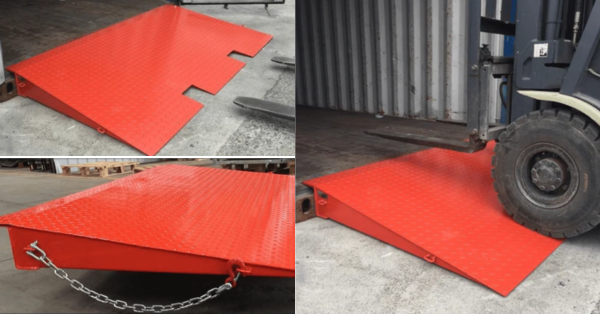
A standard container ramp is designed for this configuration, as well as moving pallet jacks and forklifts in and out. Due to the size and weight, a forklift may be required to move a standard container ramp (using the tyne pockets at the front or side of the ramp).
If a standard container ramp sounds like a good fit, we recommend the Heeve Industrial Series Forklift Container Ramp. This ramp is designed for medium to heavy-duty use, supporting between 8 - 12 tonnes.
Fold-Out Or Two-Piece Container Ramp
Most fold-out or two-piece container ramps are designed for standard shipping containers. The difference? They come with a “flip over” extension, which helps to level out uneven ground or create a shallower incline.
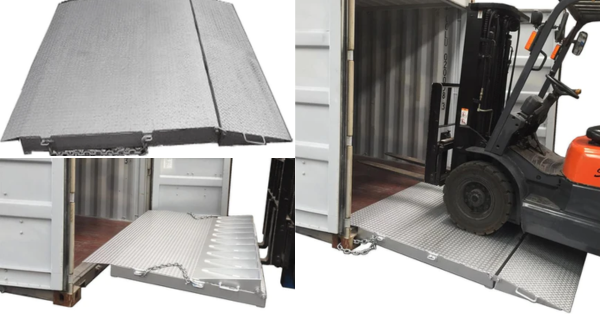
If this sounds like what you’re after, the DHE 8-Tonne Steel Container Ramp is a popular choice. This ramp fits standard containers and features an anti-slip surface and tyne openings so you can move it safely and securely.
Long Container Ramp
As the name suggests, this is a long ramp (usually in a standard 3m length). This gives you extra space to move around when you’re stuffing and de-stuffing containers, adding a layer of safety when moving pallets or operating a forklift.
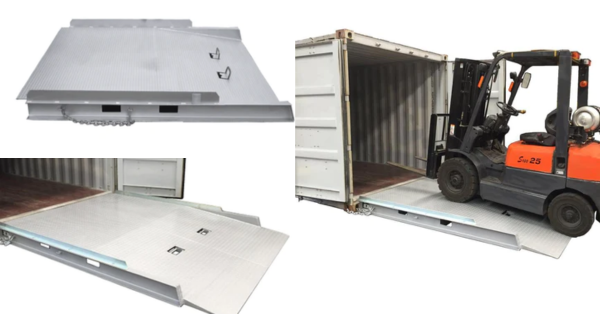
We recommend the DHE 8-Tonne Steel Container Ramp — Long (with greater load capacity also available). This ramp features an anti-skid surface, tyne openings, safety chains and can accommodate the weight of most forklifts.
Reefer Or Refrigerated Container Ramp
Reefer or refrigerated containers usually have a higher entry point than standard containers. For this reason, these containers need a specialised ramp (the standard size won’t be the right size or incline).
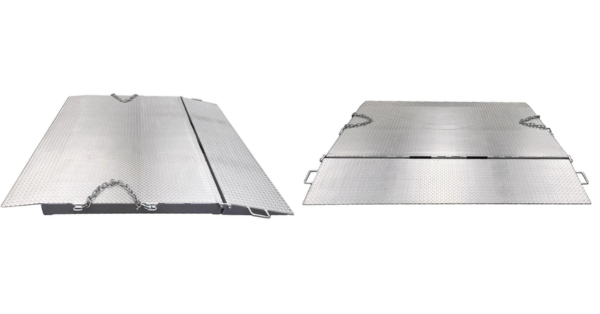
Most reefer ramps are higher and have longer flaps — some are also self-levelling.
As for recommendations, we love the DHE 8-Tonne Refrigeration Self-Levelling Heavy Duty Container Ramp. The self-levelling lip ensures a stable transition.
Lightweight Container Ramp
If you’re looking for an easy and portable container ramp for lighter loads or trolleys, a lightweight container ramp could be the way to go.
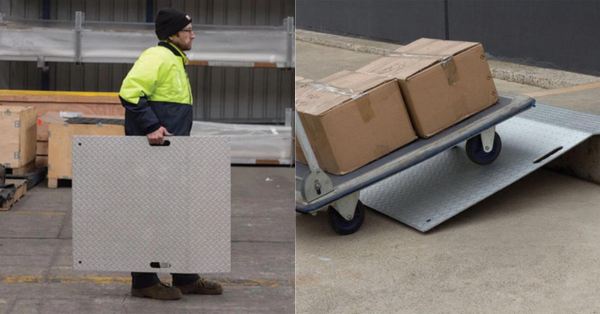
They’re typically made of aluminium (sometimes rubber or steel) and often have handles on the side for easy transportation. They’re suitable for most standard (6m and 12m) containers.
We recommend the Barrier Group Portable Aluminium Trolley Ramp. This ramp holds a weight of 300kg and comes with two stainless steel locking pins to hold it in place.
Container Ramp Features You Need To Consider
Now you’ve had a look around at our range, are there any other features you should be looking for?
Tyne Pockets
Tyne pockets (or tyne openings) allow a forklift to easily move a ramp — especially since many heavy-duty options on the market are too heavy to lift manually. Tyne pockets are usually located on the front or side of the ramp.
Always consider the use and weight of your ramp — and check if it has tyne pockets if you plan on using it in this way.
Sideguards
Raised side rails add an extra layer of safety, preventing sliding off if you’re operating a forklift, pallet truck, cart or trolley.
Platform Length
Many container ramps will have a flat platform at the top of the ramp to help with loading and unloading.
So, another thing to consider is the length of this platform, as this will ultimately impact how you can use the ramp and load the container.
For example, if using a forklift on a ramp that has a very short platform, the machine will be more angled. The back wheels may even rest on the angled section, which may make it difficult to access the first pallets in the container.
Given this, it’s also important to consider how high the pallets will be sitting and how close to the doorway they’ll be. If you plan on having them stacked high and close to the door, you’ll most likely consider a ramp with a longer platform length, like the Troden 8-Tonne Extra Long Steel Container Ramp.
How Ramp Champ Can Make Moving Your Goods From A To B, Simple
At Ramp Champ, we have Australia’s largest range of ramps. We’ve been helping businesses — big and small — find the right container ramp since 2016. With so many options on the market for a whole range of uses, we’re guaranteed to have the right fit.
If you have any questions, our friendly team is here to help you find the right ramp. Give us a buzz on 1300 913 047 or email us at hello@rampchamp.com.au





